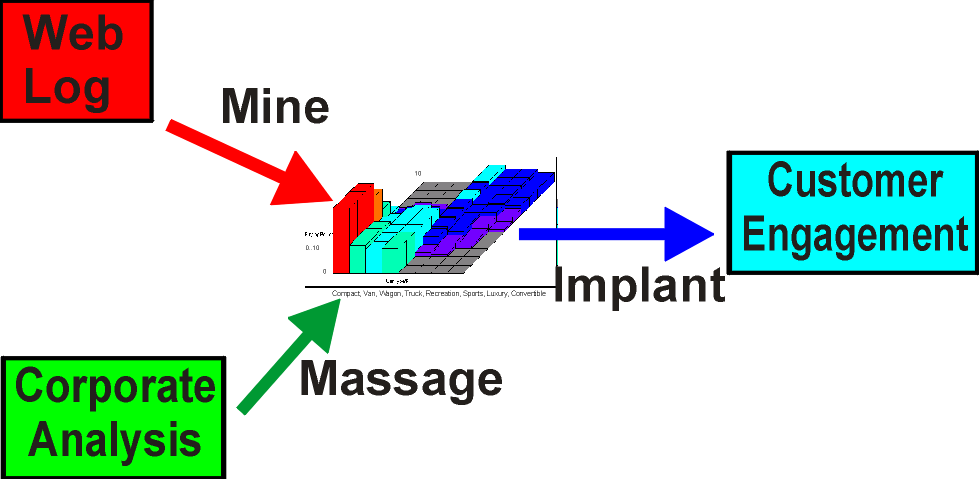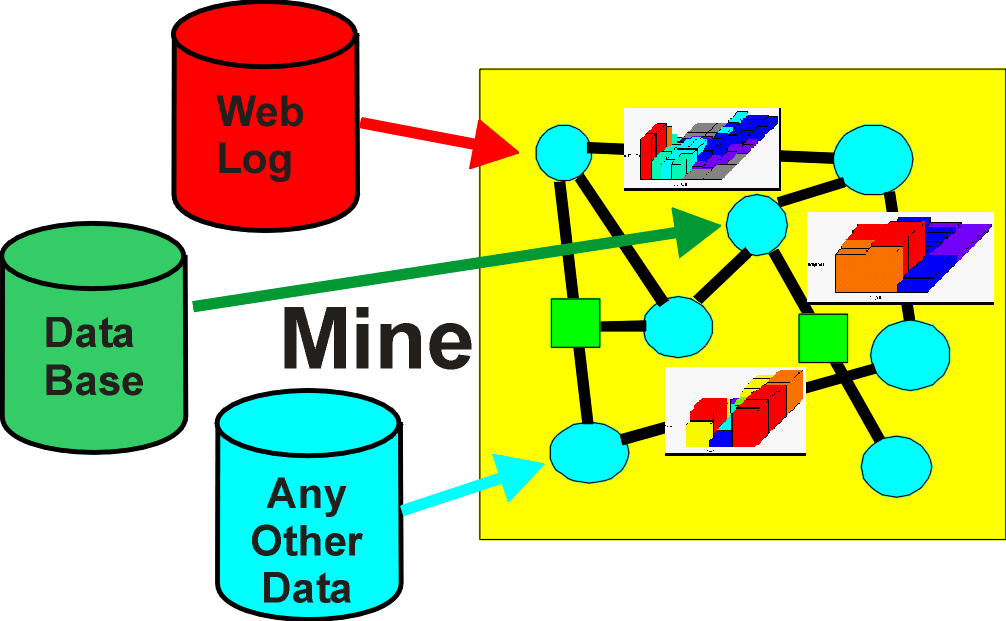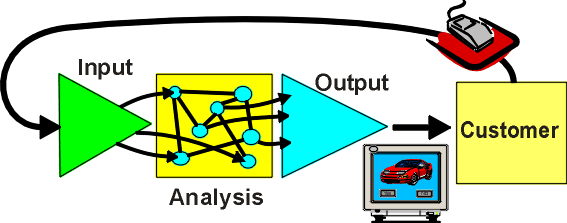

The basic process that Tupai uses is to Mine the Web Log and other data, Massage the resulting Sales Experience to include changing corporate goals, then Implant that modified experience in the "head" of the Virtual Sales Agent which will attend to the particular Sales Transaction.
Tupai's eCognition technology tightly couples these different parts of the process together because it uses a consistent knowledge network methodology to handle the Mining, Massaging and the Customer Engagement.
The knowledge network can handle complex analysis in the Mining stage, so a clickstream in a Web Log can be converted to a conceptual level which can be understood by the company’s marketing experts. These experts can then Massage the selling experience to include new products and policies.
The modified Sales Experience becomes part of the web of analytic and experiential knowledge that makes up the Virtual Sales Agent that handles Customer Engagement. The Virtual Agent need not be just a Customer Profiler and Order Taker, and can be used to do complex analysis in its own right where such analysis is relevant to the sale, analysis such as the most suitable insurance policy for an insurance transaction, or analyzing pipe flows to recommend a particular pump for a hardware company. This ability to combine and integrate analysis and experience is unique to the knowledge network methodology of eCognition.

The Tupai Web and Data Mining tools provide a powerful, intuitive way of converting data in databases and Web logs into information that can be used during a Customer Engagement.
During the Mining phase, a database table or log is dynamically connected to variables in an eCognition knowledge network model. For each record, data flows through the model in a Learning phase and builds up distributions and multi-dimensional relations connecting the variables. The model allows any kind of analysis or filtering of the data during this process, so data can be translated into higher level conceptual information. Higher level structures that are implicit in the database, such as aircraft trips represented by several records, can also be captured and analyzed. The result of the data flow Learning phase is probability maps representing Customer Behavior. These maps can be "sliced and diced" to be viewed any way the analyst desires, while maintaining correlations among the variables.
The resulting distributions and relations can be made active, so that their interactions can be immediately analyzed. The data in the database has been transformed into active knowledge. The information that flows through the model is not limited to single values, but can be sets and ranges, capturing much more effectively the knowledge that was implicit in the database, but very hard to see if each record were viewed one at a time. New relations can be found using the correlations that were in the data and are now in the knowledge representation.
The finding of new relations can be automated, using correlations in existing relations to search for more complex assemblages, or be guided by the analyst.
The necessity for finding "rules" is greatly reduced, as the relations themselves, carrying the statistical probabilities of customer behavior, can be implanted in the Virtual Sales Force directly. The distributions and relations already have a Probability Control on their operation, so supersede the need for a rule which works 76% of the time. The distributions and relations work 100% of the time, because they carry, in greatly compacted form, 100% of the behavior.
Massaging the InformationWe have turned data into information in the Mining phase, but how much of it is any good?
The Web Site must respond rapidly to everything that is happening. We are introducing a new product, altering the conditions on a policy, shutting down a service, trying to change people’s perceptions. All these influences mean we need some way of pushing around our experience so, by changing our Web Site’s behavior, we can change the future behavior of visitors to it.
Tools are needed to change the behavior of the Web Site, tools that are easy to use yet retain consistency of behavior. Tupai provides an analytic and graphical environment in which the effects of changes can be simulated and the contents of distributions and relations, reflecting experience, can be changed simply and easily, yet with excellent visualization of what is happening.
The contents of the distributions and relations can be displayed, along any axis, using the graphical display tools. Making a change is as simple as clicking on a cell and dragging its contents, effectively changing the probability of occurrence of the conditions that the cell represents. The system provides some accounting of probability, so the probability of all behaviors will still total 100%. This handles changing of the experience driving the site. Marketing or corporate specialists can also add or modify any analysis that the Virtual Sales Agent is capable of. That is, the analytic knowledge isn’t buried in a program, but is at the same level as the rest of the knowledge the Virtual Agent uses when interacting with customers, and has the same "knowledge" feel to it, so it uses whatever information the customer can provide.
The Virtual Sales Agent has three components, an Input Structure responding to user clicks, an Analysis Structure, and an Output Structure determining which web page and components are to be displayed. The Input and Output components, as their names suggest, are strongly directional and are linked with the structure of the Web Site. The Analysis component is undirected, as it needs to respond to any new piece of information by transmitting it in any direction where the new information may have an influence on behavior. An example of this is that selection of a vehicle color may tell us something about the Gender of the customer, which we can use elsewhere to predict other preferences, or telling us about Gender will allow us to predict vehicle color.

The distributions and relations that have been found in the Mining phase and massaged in the Corporate Analysis phase are implanted in the Analysis Structure of the Sales Agent. The implanting can take the form of copying the contents of a particular relation, or copying some of the structure of the higher level models into the Virtual Sales Agent model. This method allows both new Analysis and Experience to be moved into the Sales model.
The knowledge network methodology used for the analysis is general purpose, so any other financial or engineering analysis can be mixed in with the analysis necessary for the sales transaction. This extensibility removes the need for a plethora of little programs doing specialized calculations, and makes everything knowledge based.
The elements of the system can provide a Cognitive Core for a company Web Site. The integration of Web and Data Mining, Massaging of the information, and Implantation of the information in the Customer Engagement operational process allows corporate control and rapid response.
The easy addition of analysis and experience to the operation of the site allows for a continuous increase in sophistication of the site’s behavior, together with appreciation by the potential customer that the site is responding to their needs. It can have the unobtrusive personal touch of the neighborhood grocer, while still being capable of the most difficult analysis of options on the customer’s behalf.